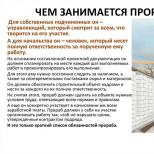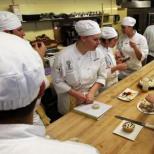Confectioner is a profession. Description and features. Profession Confectioner (3rd grade) in the Unified Tariff and Qualification Handbook Confectioner of 3rd grade must be able to
Today, the profession of a pastry chef is popular and is considered quite popular. Confectioners specialize in the mastery of sweets. Thanks to their work, consumers can delight themselves with waffles, cookies, cakes, muffins, chocolate, jelly, ice cream, jam, as well as other types of desserts and pastries.
Cooking different types of dough, fillings and creams, as well as semi-finished products for subsequent baking - these are the duties that the profession of a pastry chef implies. A description of the profession, qualities, skills and responsibilities will be given below.
What is the peculiarity of working as a pastry chef
The specifics of the profession can be called the fact that the confectioner is forced to do a significant part of the work with his hands. Often this applies to the manufacture of decorative elements of dishes and decoration of products (cakes, pastries).
Unlike a pastry chef, a confectionery specialist is a master with more versatile skills. The program includes training in the preparation of soups, snacks and other culinary delights.

Qualifications and grades
To determine the skill level of confectioners, a division of specialists into six categories has been introduced. With an increase in the rank, the master acquires additional skills that testify to his professionalism and help him to perform more complex tasks.
The characteristic of the discharges is as follows:
- First. At the very beginning of his career, the pastry chef is engaged in cutting ready-made biscuits, delivering semi-finished products to workplaces, loading filling and creams into machines, as well as controlling the operation of equipment. More and more complex tasks can be performed by such a beginner only in the presence of masters with extensive experience.
- Second. The pastry chef, who is at this stage of mastering the specialty, is entrusted with making creams, whipping and coloring them, boiling syrups, cutting biscuits, and lubricating them with filling. Cooking some semi-finished products, placing the dough in the machine, starting and adjusting its operation are also performed by the novice pastry chef. This profession is not simple, therefore, to receive each next category, the masters have to pass exams.
- Third. Having received this qualification, the master can make simple types of confectionery and bakery products, prepare some types of creams, fillings and dough. He is also trusted to cut semi-finished products, decorate sweets with fondant or glaze.
- Fourth. At this level, the program of the pastry profession involves the training of masters in the preparation of certain types of rolls, cookies, cakes from all types of raw materials. They can also choose creams in accordance with the dish and prepare individual elements that make up complex decorations (cakes).
- Fifth. After receiving this rank, the pastry chef is assigned additional duties. While still under the supervision of a senior master, he is responsible for the correct course of the process of making custom cakes, ordered individually. Also, a pastry chef, whose profession is always inextricably linked with sweets and desserts, gets the opportunity to control the work associated with the manufacture of sweets, can decorate cakes and pastries with complex finishes.
- Sixth. A professional of this level is capable of making complex curly highly artistic confectionery products. He is able to select the necessary materials in accordance with the color and size, as well as independently prepare the most complex of them. In addition, a sixth grade confectioner can develop a technology and recipe for making sweets.

Confectioner (profession): advantages and disadvantages
When choosing a future profession, it is worth carefully weighing all its inherent advantages and costs. Chefs and pastry chefs will always be in demand, as the demand for their services remains consistently high. By improving their skills, a craftsman can build an excellent career and earn good money.
For a talented worker in this field, there are many opportunities for self-realization in the role of an employee or as an owner of their own company.
Speaking about such a specialty as a pastry chef, whose profession is associated with many dangerous factors, it is worth highlighting the risk of injury and the occurrence of a number of diseases. Craftsmen, who are practically their entire working day in a standing position, are prone to lesions of the joints of the legs and spine. The effect on the human body of high temperature and humidity is also unfavorable.

In order to reduce the number of injuries due to contact with sharp and hot objects, all cooks and pastry chefs are instructed in safety precautions both during training and at the place of work.
What qualities should a good pastry chef have?
When deciding to start learning the confectionery craft, you should take into account your predisposition to this particular type of work, as well as the correspondence of temperament, character and abilities to the requirements that this profession imposes on the master.
To fully master the intricacies of the confectionery craft, you should have the following qualities:
- developed sense of smell and delicate taste sensations;
- excellent memory, which is useful for memorizing ingredients and recipes;
- developed imagination;
- sleight of hand and the ability to quickly switch between different types of work (after all, many processes and operations are performed simultaneously);
- physical endurance.

What it takes to become a virtuoso pastry chef
The traits listed above, combined with a decent education, will make it possible to work successfully in the kitchen. However, to go beyond the average pastry chef and become a top-ranking specialist, you cannot do without artistic taste, ingenuity and creativity.

In addition, in the course of his work, the pastry chef interacts with the team members and superiors, therefore, they are expected to be patient, self-possessed, friendliness, benevolence and sociability. Sloppy, careless and careless workers are not successful in this field of activity.
How to become a pastry chef
Many educational institutions offer special programs and courses. Given the demand for the profession of a pastry chef, training quickly begins to bear fruit.
Elementary knowledge is taught in institutions of primary and secondary vocational education. To obtain the qualification of a confectionery production technologist, you need to enter a higher educational institution. The curriculum guided by teachers in public and private institutions must comply with statutory standards.
The Federal State Educational Standard of the pastry profession regulates the content and process of presenting information to students, and also determines the result of training in the form of specific skills and abilities of graduates.
Where a pastry chef can apply his abilities
Having received education, the master can be admitted to the staff of a bakery, catering establishments (cafe, restaurant, canteen), to health camps or to a sanatorium. In addition, all educational institutions, without exception, employ confectioners.
As a master of confectionery production, you can get a job at a blank factory or a factory for semi-finished products.
Career steps
Career growth within a certain enterprise is possible for those confectioners who have managerial skills and ambitions. They become the leaders of the shift, workshop or production.
For those wishing to test their strengths in private entrepreneurship, there is an opportunity to open their own confectionery or bakery.
Description of works... Cutting with a knife or knocking out the baked biscuit from the mold. Cleaning of forms and biscuits. Delivery of semi-finished products to workplaces. Loading the spreading machine with cream or filling and regulating its operation. Performing more complex operations under the guidance of a more qualified pastry chef.
Must know: requirements for the quality of baked biscuits for cakes and pastries; rules for servicing the spreading machine.
§ 43. Confectioner of the 2nd category
Description of works... Performing individual work in the process of making cakes, pastries and shaped cookies. Preparation of syrups and creams, whipping and coloring cream, boiling syrup. Laying out, leveling and cutting the biscuit to size into layers for cakes and pastries. Stuffing or spreading cakes and pastries with cream or filling by hand or on spreading machines with regulation of the thickness of the layer of cream or filling. Preparation of semi-finished products for certain types of confectionery. Checking the weight of piece products. Control according to the testimony of instrumentation for the quality of cooking syrup. Semi-finished product supply to the workplace. Conducting the process of forming complex shape cookies. Filling the deposit bags with dough and manually depositing cookies or cakes on sheets. Jigging cookies of the "Ukraine" type on jigging machines. Filling the jig cylinder with dough. Monitoring the quality of jigging. Removing the formed dough from the depositor and placing it on sheets. Making sandwiches by car. Checking the quality of incoming cookies, fillings, creams. Starting and stopping the sandwich making machine, regulating its operation. Loading into the drums of the serviced machine cream or fillings. Biscuits are fed by a conveyor onto cassettes, application of fillings, cream, cooling in a refrigerator, laying on a conveyor. Packing of cakes, pastries and figured cookies.
Must know: technology and recipes for the preparation of syrups, creams, the manufacture of sandwiches, semi-finished products for certain types of confectionery; methods of coloring creams; assortment of manufactured confectionery products; types of raw materials, flavoring and aromatic substances, rippers and dyes used for the manufacture of confectionery products; the principle of operation and the rules of operation of the serviced equipment.
§ 44. Confectioner of the 3rd category
Description of works... Conducting the process of making simple mass cakes, pastries and other piece confectionery and bakery products with a stencil drawing according to a standard in one paint or with a simple combination of paints from various types of raw materials: flour dough, curd mass or ice cream. Preparation of various types of dough, creams, fillings. Procurement, weighing, measuring of raw materials according to a given recipe. Kneading, churning dough, blotting, rolling to a certain thickness, adding flour to the dough. Cutting the obtained semi-finished products. Stamping, forming and depositing products on sheets. Decorating products with fondant, marzipan, candied fruits, chocolate, cream. Transfer of ice cream products to hardening.
Must know: flour varieties and its properties (quality of the formed gluten); recipes and modes for the manufacture of simple mass cakes, pastries and other piece confectionery products with a stencil drawing according to the standard in one paint with a simple combination of colors; methods of finishing confectionery products with fondant, marzipans, candied fruits, chocolate, cream; device of the serviced equipment.
§ 45. Confectioner of the 4th category
Description of works... Conducting the process of making muffins, rolls, cookies of various assortments, complex types of cakes and pastries from various raw materials: flour dough, curd mass or ice cream with a multicolor pattern, separate arrangement of small and medium details of the pattern and sharp traditional transitions of tones. Figured cutting of baked semi-finished products. Forming. Manufacturing of drawing details, decorations for chocolate, cream, meringue cakes. Selection of cream by color. Application of a pattern. Installation of a picture from various small and medium-sized parts. Visual check of the alignment of colorful elements and details of the drawing, the weight of finished cakes and pastries.
Must know: technology and recipes for making cupcakes, rolls, retail biscuits, complex cakes and pastries with a multicolored pattern; ways of mounting the picture.
§ 46. Confectioner of the 5th category
Description of works... Leading the process of making highly artistic, original, curly, national, custom-made cakes according to specially developed proprietary recipes under the guidance of a pastry chef of higher qualifications. Manufacturing of individual baked and finishing semi-finished products. Conducting the process of making sweets for sets of the "theater", "chocolate" type. Preparation and quality control of raw materials, fillings, finishing semi-finished products. Forming of dough pieces, artistic finishing of complex types of products.
Must know: recipes and foundations of the technology for the production of highly artistic, curly, custom-made, national cakes; manufacturing technology and recipes for sweets included in "chocolate" and "theater" sets, creams, syrups, individual baked and finishing semi-finished products; methods and techniques of artistic finishing of confectionery products.
Section 47. Confectioner of the 6th category
Description of works... Conducting the process of making highly artistic, original, curly, custom-made, national cakes. Forming complex-shaped dough pieces. Sophisticated artistic decoration of products. Selection of finishing materials by color, shape, size. Installation of a picture from various small and medium-sized parts. Development of recipes and technologies for the manufacture of branded cakes and pastries.
Must know: manufacturing technology of highly artistic, original, curly, custom-made, national cakes; rules and techniques for developing recipes for baked cakes and finishing semi-finished products; requirements for the quality of cakes; methods and techniques of highly artistic finishing of confectionery products.
Secondary vocational education is required.
I APPROVE:
[Job title]
_______________________________
_______________________________
[Name of company]
_______________________________
_______________________/[FULL NAME.]/
"______" _______________ 20___
JOB DESCRIPTION
Confectioner of the 3rd category
1. General Provisions
1.1. This job description defines and regulates the powers, functional and job responsibilities, rights and responsibilities of the 3rd category pastry chef [Organization name in the genitive case] (hereinafter - the Company).
1.2. A confectioner of the 3rd category is appointed and dismissed in accordance with the procedure established by the current labor legislation by order of the head of the Company.
1.3. A confectioner of the 3rd category belongs to the category of workers and reports directly to the [name of the position of the immediate supervisor in the dative case] of the Company.
1.4. A person with a vocational and technical education, appropriate training and work experience in the specialty for at least 1 year is appointed to the position of a pastry chef of the 3rd category.
1.5. In practical activities, a confectioner of the 3rd category should be guided by:
- local acts and organizational and administrative documents of the Company;
- internal labor regulations;
- rules of labor protection and safety measures, ensuring industrial sanitation and fire protection;
- instructions, orders, decisions and instructions of the immediate supervisor;
- this job description.
1.6. A confectioner of the 3rd category should know:
- flour varieties and its properties (quality of the formed gluten);
- recipes and modes for the manufacture of simple mass cakes, pastries and other piece confectionery products with a stencil drawing according to a standard in one paint with a simple combination of paints;
- methods of finishing confectionery with fondant, marzipans, candied fruits, chocolate, cream;
- device of the serviced equipment.
1.7. During the temporary absence of the 3rd grade pastry chef, his duties are assigned to [the name of the position of the deputy].
2. Job responsibilities
A confectioner of the 3rd category carries out the following labor functions:
2.1. Conducting the process of making simple mass cakes, pastries and other piece confectionery and bakery products with a stencil drawing according to a standard in one paint or with a simple combination of paints from various types of raw materials: flour dough, curd mass or ice cream.
2.2. Preparation of various types of dough, creams, fillings.
2.3. Procurement, weighing, measuring of raw materials according to a given recipe.
2.4. Kneading, churning dough, blotting, rolling to a certain thickness, adding flour to the dough.
2.5. Cutting the obtained semi-finished products.
2.6. Stamping, forming and depositing of products on sheets.
2.7. Decorating products with fondant, marzipan, candied fruits, chocolate, cream.
2.8. Transfer of ice cream products to hardening.
In the event of an official need, a confectioner of the 3rd category may be involved in the performance of his official duties overtime, in the manner prescribed by law.
3. Rights
A confectioner of the 3rd category has the right:
3.1. To get acquainted with the draft decisions of the management of the enterprise concerning its activities.
3.2. Submit proposals for improving the work related to the responsibilities provided for by this job description for the management's consideration.
3.3. Inform the immediate supervisor about all deficiencies in the production activities of the enterprise (its structural divisions) identified in the course of the performance of their duties and make proposals for their elimination.
3.4. To request, personally or on behalf of a direct supervisor, from the heads of departments of the enterprise and specialists, information and documents necessary for the performance of their official duties.
3.5. To involve specialists from all (individual) structural divisions of the Company in solving the tasks assigned to him (if this is provided for by the provisions on structural divisions, if not - with the permission of the head of the Company).
3.6. Require the management of the enterprise to assist in the performance of their duties and rights.
4. Responsibility and performance evaluation
4.1. A confectioner of the 3rd category bears administrative, disciplinary and material (and in some cases stipulated by the legislation of the Russian Federation - and criminal) responsibility for:
4.1.1. Failure to comply or improper fulfillment of the official instructions of the immediate supervisor.
4.1.2. Failure to perform or improper performance of his labor functions and the tasks assigned to him.
4.1.3. Misuse of the granted official powers, as well as their use for personal purposes.
4.1.4. Inaccurate information about the status of the work entrusted to him.
4.1.5. Failure to take measures to suppress the identified violations of safety regulations, fire safety and other rules that pose a threat to the activities of the enterprise and its employees.
4.1.6. Failure to enforce labor discipline.
4.2. Assessment of the work of the 3rd grade pastry chef is carried out:
4.2.1. Immediate supervisor - regularly, in the process of the employee's daily performance of his labor functions.
4.2.2. The attestation commission of the enterprise - periodically, but at least once every two years, based on the documented results of the work for the evaluation period.
4.3. The main criterion for assessing the work of a 3rd grade pastry chef is the quality, completeness and timeliness of his performance of the tasks provided for in this instruction.
5. Working conditions
5.1. The work schedule of the 3rd grade confectioner is determined in accordance with the internal labor regulations established by the Company.
5.2. In connection with the production necessity, the confectioner of the 3rd category is obliged to go on business trips (including local ones).
Acquainted with the instructions ___________ / ____________ / "____" _______ 20__
DetailsHis salary, work experience depend on the category of a pastry chef and, of course, this symbolizes another aspect - the professionalism of a specialist. How many categories do pastry chefs have in total, what is the difference between them, and with what category of pastry chefs is a career just beginning?
The profession of a cook, and with it a pastry chef, came to us from hoary antiquity, when someone, after a successful hunt, came up with the idea of roasting a slice of a dead mammoth on a fire, and then baking a date, thereby obtaining a roast and the first sweets. What is more important now, lunch or dessert, we will not argue. Instead, let us bow to the master chef who managed to prepare a miracle.
And before the praise there was a difficult professional path, daily “standing” on our feet, heat near the stove or oven. Time passed, and with it the pastry chef rose to a new professional level.
How does the ranks of confectioners affect their work?
These days it’s not easy to learn how to cook and bake. It is necessary to choose an educational institution of the corresponding direction, to unlearn in it the allotted time, to receive a diploma and a certificate of qualification category. As a rule, after graduating from a school or college, graduates receive a third qualification category.
The ranks of the pastry chef determine the processes that he can carry out. Assistants to pastry chefs, people with no education, have the initial grades. Their actions are "bring - give - take away."
With the third category of a pastry chef, you can get an independent place to work in a catering enterprise, but a specialist will perform the simplest operations: weigh products, knead dough and cook the simplest products. Naturally, such work will be paid low.
The next two ranks of the pastry chef raise the skills of the pastry chef, who bakes cookies on his own, and, moreover, of different types, decorates cakes and starts making sweets.
The last qualifying category of a pastry chef assumes that the pastry chef has fully mastered the culinary and confectionery business, has become a high-class specialist who knows everything and can bake any confectionery product from start to finish. The final process is the process of decorating a product that can be made copyrighted. A confectioner of this category can bake products according to his own recipes. Such a pastry chef can carry the title of "master" or "pastry chef" and claim the highest paying job.
What does a 5th grade confectioner mean?
Confectioner of the 5th grade - this means knowing the technology for preparing all kinds of products and being able to perform certain processes of confectionery.
A specialist of this category knows and can:
- Familiar with various and original recipes for sweet products;
- Can make different types of sweets using different technologies;
- Knows how to decorate pastries using different technologies.
A grade 5 pastry chef has a job description that, in five points, contains the complex process of baking and making sweets. The pastry chef is allowed to conduct all the processes, the only thing that he is not allowed to do the instructions is to cook products according to his own recipe.
The instruction also defines the rights and responsibilities of the pastry chef. The rights impose great powers on the pastry chef, for example, to make adjustments to the activities of the enterprise and to propose methods that bring efficiency to the work of the department. But such a pastry chef is not a manager, although the staff of the department is subordinate to him.
What are the ranks of pastry chefs for?
The ranks of pastry chefs determine the responsibilities of each specialist, both a person with little work experience and one with a long work experience. Of course, it is difficult to blindly follow the ranks of pastry chefs and differentiate between the actions of specialists of different ranks, and it is not worth it. . Indeed, with such a simplified approach, a specialist in one category will never be able to master the skills of another. The pastry chef should always strive to perform more complex processes in order to quickly obtain management approval for course retraining, which ends with an increase in the qualification level of pastry chefs.
A few tips for representatives of the confectionery and cooking class.
If, indeed, the specialist felt that the chosen specialty is his vocation, then you need to make every effort to have opportunities for professional growth. Means a visit is necessary confectionery courses maybe even study abroad to get acquainted with new directions in the confectionery field, to rise to the level of a world-class professional. It could be training for a pastry chef at the Le Cordon Bleu culinary school in France. Of course, such courses and schools require high fees, but the material costs will pay off after several years of working as a cook or pastry chef in European restaurants.





